We are all wired to play and be playful. Evolution psychology has proved that playing is a survival mechanism.
Edward Norbeck has said: “It seems the more advanced a species is on the evolutionary scale, the more frequent and diverse are its play activities.”
Having fun and humour in class is vital. They affect the chemistry of stress. Humour allows us to be natural, feel great and bond with each other. We live in interesting times, wouldn’t it be awesome to use some warm-ups in your classroom and open the doorways for learning to happen?
I have collected 60 warm-up activities for your English class or any class that will take your teaching practices to the next level. Go over the 60 warm-ups and share what worked for your students in the comment section below.
Also, find the pdf version of the 60 warm-up activities for English class below!
Enjoy ????????????????????
1 Space walk

This game is invaluable for the development of group and spatial awareness.
- “Find a space to stand in. When I clap my hands, walk
quietly around the room in any direction. Try to fill the space – move into empty areas. Keep changing direction. Try not to come into contact with other people. Now Freeze!” Check that everyone stands absolutely still, freezing every muscle. Ask them to notice areas of the room which are emptier. Repeat the exercise with any of the following variations:
- Avoid eye contact.
- Make eye contact with every person you pass.
- Every now and again, shake hands with someone and move on.
- Find a new way of moving in the space. And another way, low down. And another, high up.
- On a signal, move in slow motion, then normal, then fast, all the time being aware of other people.
- Imagine you are moving through thick snow, over ice, under water, on hot sand, through an art gallery…
- Freeze!
- Play Noses
- Make physical contact with one other person and continue moving together in the space. Find new ways of moving together.
- Move apart from your partner but maintain eye contact, without bumping into anyone else.
- And freeze again. Notice exactly where you are in relation to others around you. Run and touch each of the four walls and return to exactly the same place without bumping into anyone.
2 Splat!
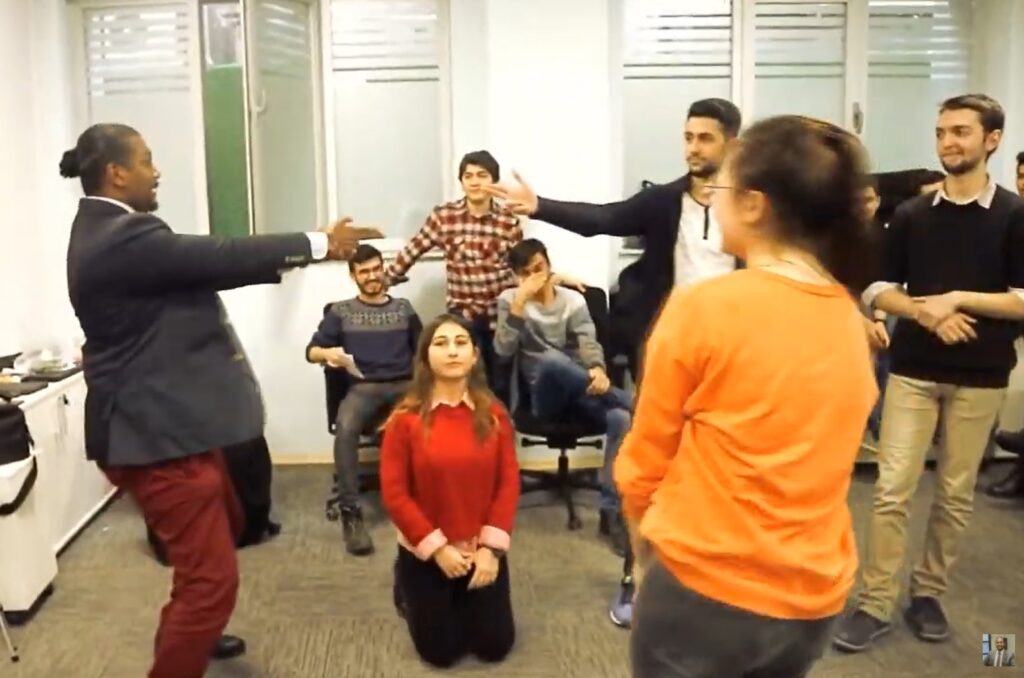
Here is a fun game for all. The group stands in a circle, facing the middle, with one person in the centre of the circle. The person in the middle then spins around, and points to a person at random, shouting SPLAT! That person must then duck down, and the two people either side must point at each other and shout SPLAT! If the first person doesn’t duck in time, they get “SPLATTED” and are out. If they do, the last person to say SPLAT on either side is out. Quite confusing at first, but good fun once you get the gang of it!!!
3 Plus one, two, three
The first student says “Yesterday I went to the store and I bought [something].” The next person adds to the first by saying “Yesterday I went to the store and I bought [something] and [something else]. Keep it simple for the lower levels. For higher levels any student can add up to three individual items at a time.
4 A + B = C
Students are given two letters of the alphabet and they must come up with words that include both of those letters. If the letters were “l” and “l” for example, the student would say “T” plus “L” =…” and then finish with a word like “towel”. The next person then has to do the same in a short amount of time. Keep going around the class until someone stumbles. The letters can be used in order or reversed, and the word can be any length, but must be one single word. Words cannot be said twice in one game.
5 Birthday Game
First, Have the group stand and line up in a straight line. Then, after they are in line, tell them to re-arrange the line so that they are in line by their birthday. January 1 on one end and December 31 at the other end. The catch is that they must do all this without talking or writing anything down.
6 Map Game

Hang a large map of the world. Give everyone a pushpin. As they enter, they pin the location of their birth on the map.
7 Toilet Paper Game

Pass around a roll of toilet paper to the group and ask them to take what they need. No further explanation.
When done. Tell the group that as they go around the room, each person must tell a fact or something about themselves for each square of TP they took.
8 Paper Airplane Game

Everyone makes a paper airplane and writes their name, something they like and dislike on it (You may also want to add additional questions). On cue, everyone throws their airplane around the room. If you find an airplane, pick it and keep throwing it for 1-2 minutes. At the end of that time, everyone must have one paper airplane. This is the person they must find and introduce to the group.
9 Yes, let’s!
Whole group game. One person starts with a suggested action – “Let’s play the piano”, for example. Everyone else shouts, “Yes, let’s!” and the whole group carries out the action with as much enthusiasm as possible. After a while someone else can suggest a new action – “Let’s be spies!” – “Yes, let’s!” The aim is for the whole group to fully commit to the activity. Try not to rush too quickly from one activity to the next – explore each one for a while. A good warm-up for impro work.
10 Twenty Questions
Here is an old favorite I play very often with my high school or university students . The students have to guess what thing the person is thinking of by asking him or her 20 yes/no questions. If no one guesses the answer after 20 tries, the answer is revealed. A “yes” answer earns the questioner another chance to ask, a “no” passes the asking on to the next player. Maybe your students are advanced enough to ask appropriate questions on their own, in my case to facilitate my weak ones I hand out a print I made with examples of questions. The first question on my print is, “Are you animal?/vegetable?/mineral?. Then below that I have written three categories of questions: animal, vegetable and mineral. Under the animal heading my first question is “Are you human?” Then I have written questions like, “Are you famous?” “Are you in this school?” “Are you a man/woman?” “Are you Japanese?” In case the animal is not human I have, “Can I eat you?” “Can I ride you?” “Are you bigger than a _____?” etc. Under the vegetable heading I wrote questions like “Can I eat you?” “Are you delicious?” “Are you in Japan?” etc. And finally under the mineral headline I wrote, “Are you metal/ plastic/ stone/ wood?” “Are you [blue]?” “Do I have you?” “Are you in the classroom?” “Can I see you?” By using the print my students get a feel for asking questions in English and I have found many no longer need to refer to the paper. I hope you have good luck playing this great word game.
11 How do you like your neighbour?
Equipment: A circle of chairs for all involved except for one person.
One person stands in the middle of the circle of chairs and announces “I like my neighbour who”…. eg. …is wearing sneakers … has brown hair, etc. Everyone who fits the statement must move (run) to another chair. The object is for the person in the middle to find an empty chair. This is a lot of fun and can be played for a long time. Remember to use your imagination.
12 Boppity bop bop bop
Get the group to stand in a circle. Everyone remains standing and there is one person in the middle. The person in the middle will go to someone and point saying “zip” or “zap”. Zip means left and Zap means right. When the person in the middle says “Zip” the person to whom they are pointing must say the name of the person on their left before the person in the middle says “Boppity bop bop bop”. If the person who is in the circle cannot do this, then they change places with the person who is “it” in the middle. This activity is great with older kids (14-19yrs).
13 Baby! What time is it?!
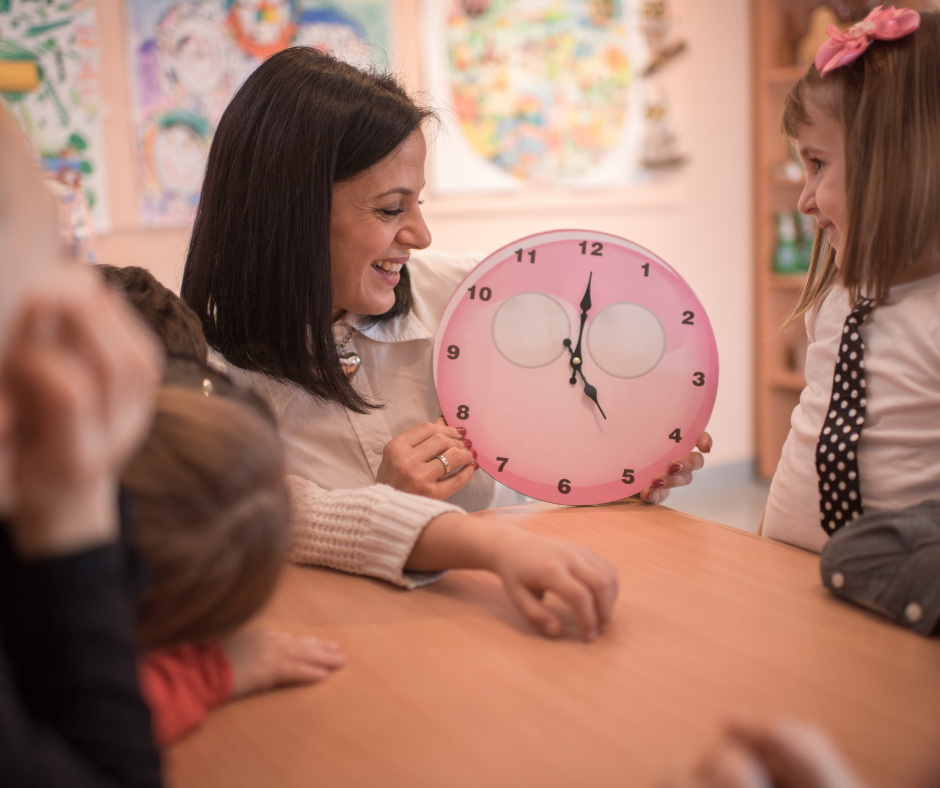
When teaching basic time-telling skills I devised this game. It’s good for beginners/children, but wears out after one or two uses, yet is quite effective and fun. Draw two blank clock faces on your white/black board and divide the class evenly (or even into thirds, etc.). Have one student from each group come to the board and have them race to draw the big and little hands properly when you tell them the time. This is a great way to install the concepts of quarter to and after, half past, five of, almost, on-the-dot, straight up, noon/midnight etc. Prizes aren’t necessary if you can drum some team spirit, but chocolate never hurts for the winners.
14 The Shoe Game

When entering, everyone must take off one shoe and leave it in a pile at the door. They keep the other shoe on. After everyone is in. The host will distribute the shoes to people not wearing the same shoe. When instructed, everyone must find the mix and find the person who belongs to the shoe and get some info about them. They then introduce their new friend to the group.
15 The Artist Game
Give everyone a piece of paper and a pencil. In 5 minutes they must draw a picture that conveys who they are with out writing any words or numbers. At the end of 5 minutes the host collects the pictures. Show the pictures to the group one at a time and have them try to guess who drew it. After this allow each of the artists to introduce themselves and explain how their work clearly conveys who they are.
16 Three in Common Game
Break the group into 3’s. Their objective is for each group to find 3 things they have in common. But not normal things like age, sex or hair color. It must be three uncommon things. After letting the groups converse for 10 – 15 minutes, they (as a group) must tell the rest of the groups the 3 things they have in common.
17 Group juggle
There are several variations of this game. A ball is thrown across the circle from one person to the next. Once the action is going smoothly, a second ball is introduced, perhaps of a different size or colour. This one could be bounced or thrown across the circle. You can continue adding as many balls as the group can manage. It is important to maintain focus and to stop and start again if the game gets out of control. As ever, communication is essential – just as it is between actors on stage. Make sure you have eye contact before you throw. Group members should aim to take responsibility for each another.
- In one variation a single ball is thrown so that everyone catches it once. Then the group tries to repeat exactly the same pattern – but faster and faster – without making a mistake. Add in more balls one by one, to be thrown in the same order.
- Try also having one person stand in the middle of the circle. The job of the people around the circle is to throw the ball to that person, who must then throw it to somebody else. No-one should ever throw the ball until they know the person in the middle is ready. Again, more balls can be introduced. • For adults – if somebody drops the ball, they say “Oh, balls”. The game starts again when everybody is focused. This takes the edge off making a mistake.
• An amusing twist on the game is to use all sorts of objects instead of, or as well as balls – rubber chickens, cuddly toys and beanie babies.
18 Pantomime

The actors will work in groups of 4-6 and are instructed to pantomime a single general activity (examples: Playing different sports at school, performing with an orchestra, circus acts, hospital work, etc.) To communicate the idea of a GENERAL activity, each actor must pantomime a SPECIFIC one For example: “Office works”
One actor mimes being a typist, another delivers the mail, another is a “boss” at a desk (perhaps on the phone), a client visits the office to see the boss, etc.
The audience then guesses the general activity and then talks about the specific ones. Make sure the actors understand they cannot speak – only mime with their bodies, facial expressions, etc.
19 Bean Bag

This exercise demonstrates to the children how important it is to project their voices. Place three bean bags in front of a row of children. One about 10 feet away from them – the second about 20 feet away, the third about 35-40 feet away (this can obviously be changed to suit the physical environment of the class).
- Ask each child to look directly at the first bean bag, say their name and the name of their favorite animal.
- Instruct him to say the exact same things to the second bean bag
- Would he speak with the same volume? Of course not – the “person” is further away
- When asked to address the third bean bag, he obviously should be projecting his voice as loud as he can. After all the class has addressed the bean bags, let them know were really acting in a play just then – reaching the first three rows, the middle rows, and the back rows of the theatre!
20 Clap the ball
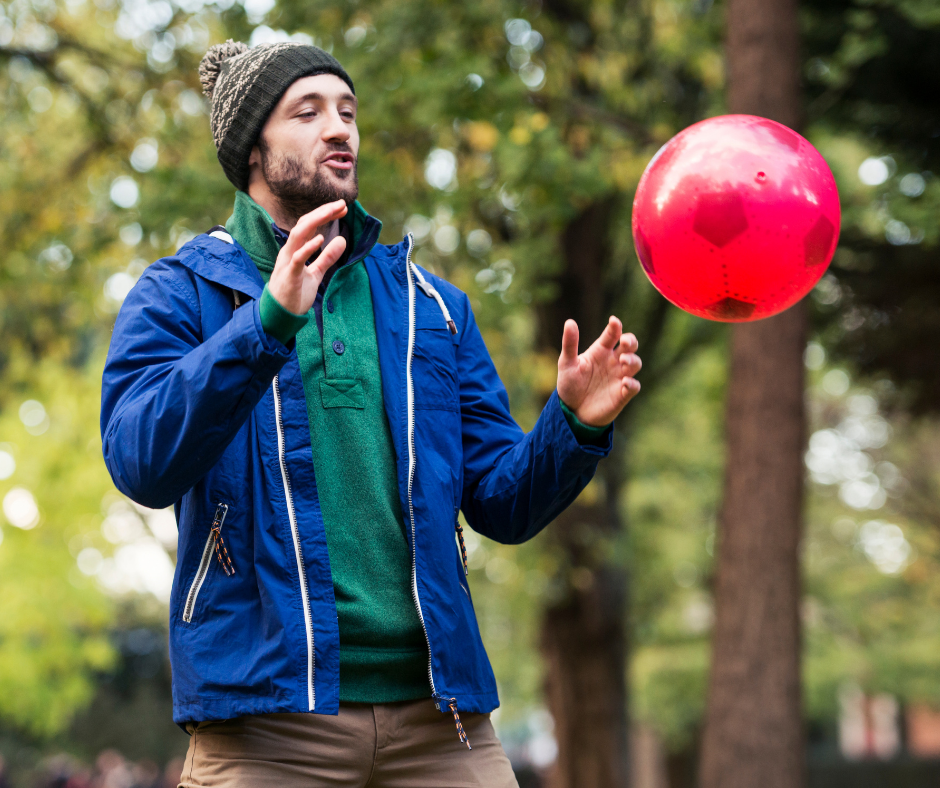
Begin by throwing a tennis ball or beanbag to each other across a circle. The person throwing the ball has responsibility for whether the other person catches it – so make sure that people are clear about whom they are throwing to. Once this is working well, introduce the idea that everyone must clap their hands in unison once, while the ball is in the air. Complicity between group members is essential. If this goes well, the game continues so that each time the ball is thrown, the group try to clap together one extra time. So the first time it is thrown, everyone claps once, the second time twice, and so on. You will probably get up to seven or eight and then it will start to get more difficult. Once it breaks down, start again from one. This is an effective way of encouraging concentration and awareness.
21 Dream Vacation Game

Ask participants to introduce themselves and describe details of the ideal, perfect dream vacation.
22 Favorite T-Shirt Game

Ask attendees to bring (not wear) their favorite T-shirt to the meeting. Once all participants have arrived, ask each person to show the shirt to the group and explain how the T-shirt best resembles their personality.
23 Famous People/Cities Game

As each participant arrives, tape a 3 x 5 index card on their back with the name of a famous person or city. They must circulate in the room and ask questions that can ONLY be answered with a YES or NO to identify clues that will help them find out the name of the person or city on their index card. EXAMPLES: Paris, Madonna, Santa Claus, John Wayne, Casablanca.
24 Favorite Animal Game

As the guests arrive, and before you write their names on a name card, ask them to tell you their favorite animal and three adjectives to describe the animal. As they tell you, write the three adjectives on a name tag BEFORE their name (omit the name of the animal). Ask them to mingle with the crowd, sharing why these adjectives best describe their own personality. EXAMPLES: Loyal, cuddly, playful Dan.
25 Creative Name Tags
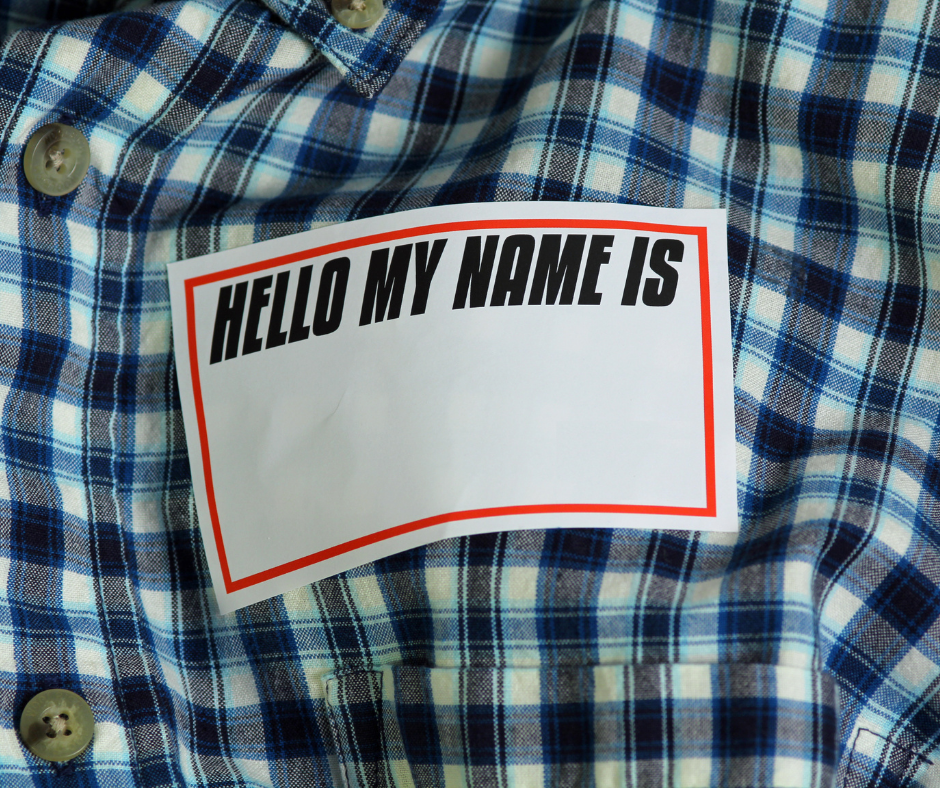
Give everyone 15 minutes to make their own name tag-they can list hobbies, draw a picture, give a self[1]profile, etc.
26 Categories
Students are given five categories (animals, fruits & vegetables, person’s name, work-related words, countries) and one letter of the alphabet (s, b, w, r, and m). In a limited period of time, they must come up with as many examples of each category that start with that letter. When the first letter is done, check everyone’s answers. If the student has a word that no one else has, that student gets a point. Then move on to the next letter.
27 Here Pussy Pussy

Get the group to sit in a circle. Put a random number in a bowl or something of that sort. Get each individual to pick a number. The one with number 1 goes in the middle of the circle, and gets down on his/her all fours and acts like a cat. The person with the number 2 then has to tap the person on the head and say “here pussy pussy” without smiling or laughing. It’s up to the group to decide whether the person should go into the middle. I have played this game a few times with various groups. It is always a good laugh especially with a group just starting up.
28 Who is it?

A chosen “guesser” goes out room. A leader is then picked from the group. Whatever the leader does the group must copy. When the “guesser” enters, they must try and see who the leader is by trying to work out who is starting the new actions off (tell the group not to all look at the leader as it makes it harder). This is a really fun game and is good to keep a small group occupied for short time.
29 Cries of animals

The game is filled with laughter and fun with the intention of forming the participants into groups of 4 – 10.
Preparation: Before one could conduct this game, he or she needs to write the names of animals (cow, cat, pig, etc.) on to pieces of paper or card. Once the group is ready to play, distribute these written slips of paper to all. Let the participants not show their slip to another person as this needs to be top secret. Then tell the group to make the sound of the animal that they have on the slip and form a family of the same animal (in one corner of the room) The group carefully listens to the similar sounds from the others. In this way, it would be easy to form the participants into groups.
30 Circle of Friends Game
This is a great greeting and departure for a large group who will be attending a seminar for more than one day together and the chances of meeting everyone in the room is almost impossible. Form two large circles (or simply form two lines side by side), one inside the other and have the people in the inside circle face the people in the outside circle. Ask the circles to take one step in the opposite directions, allowing them to meet each new person as the circle continues to move very slowly. If lines are formed, they simply keep the line moving very slowly, as they introduce themselves.
31 Marooned Game

You are marooned on a island. What five (you can use a different number, such as seven, depending upon the size of each team) items would you have brought with you if you knew there was a chance that you might be stranded. Note that they are only allowed five items per team, not per person. You can have them write their items on a flip chart and discuss and defend their choices with the whole group. This activity helps them to learn about other’s values and problem solving styles and promotes teamwork.
32 The Interview Game

Break the group into two person teams (have them pick a partner that they know the least about). Have them interview each other for about twenty minutes (You can also prepare questions ahead of time or provide general guidelines for the interview). They need to learn about what each other likes about their job, past jobs, family life, hobbies, favorite sport, etc. After the interviews, reassemble the group and have each team introduce their team member to the group. This exercise helps them to learn about each other.
33 Story Time Game

The facilitator starts a story by saying a sentence. It then goes in a circle, each person adding a sentence onto the story-after repeating each sentence that’s already been added.
34 Ball Toss Game
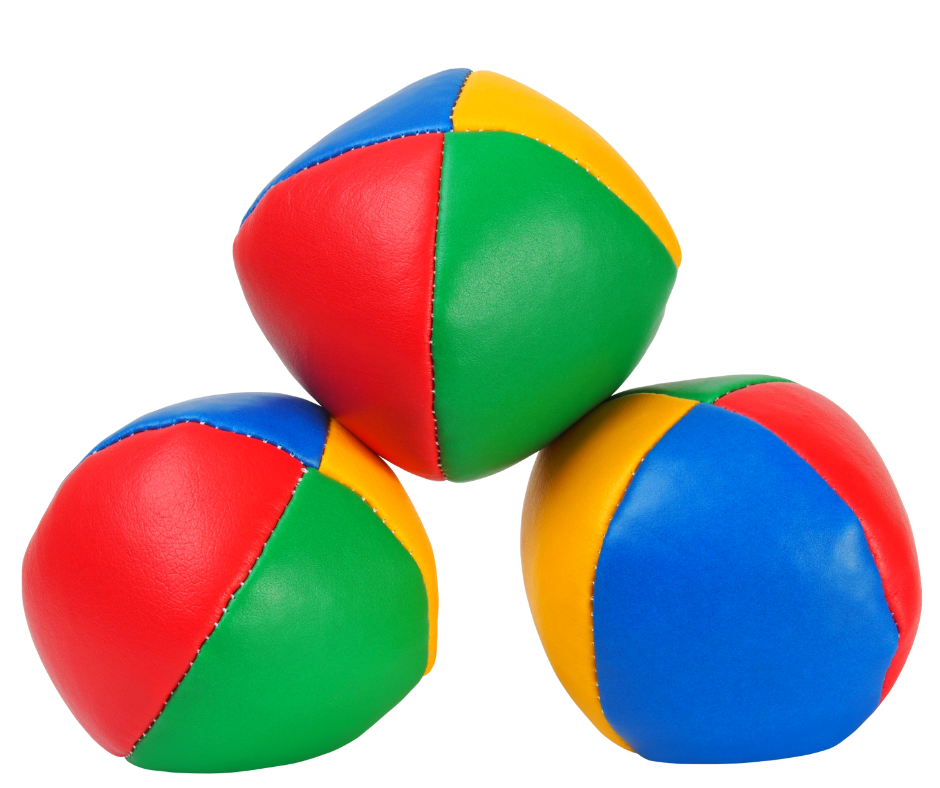
This is a semi-review and wake-up exercise when covering material that requires heavy concentration. Have everyone stand up and form a resemblance of a circle. It does not have to be perfect, but they should all be facing in, looking at each other. Toss a nerf ball or bean bag to a person and have tell what they thought was the most important learning concept was. They then toss the ball to someone and that person explains what they thought was the most important concept. Continue the exercise until everyone has caught the ball at least once and explained an important concept of the material just covered.
35 Positive Reinforcement Cards Game
Whenever a participant arrives to class on time from breaks, lunch, etc. give them one playing card. You can also hand out cards to people who volunteer for activities, are helpful, answers a difficult question, etc. At the end of the day, play one hand of poker. Give a small prize to the best hand (you can also pick the top two or three hands if you want to give away more prizes). Note that the more cards a person has, the better the chance of winning.
36 Human Bingo Game

Before the meeting, make a bingo matrix and at the top of each square put something that someone in the group might have done-for example, voted for Ross Perot, served in the Peace Corps, etc. Everyone gets a copy and is asked to circulate, getting other group members to sign one square that is true of them. The first person to get “bingo” wins the prize (a candy bar or some other small thing).
37 Sound and action
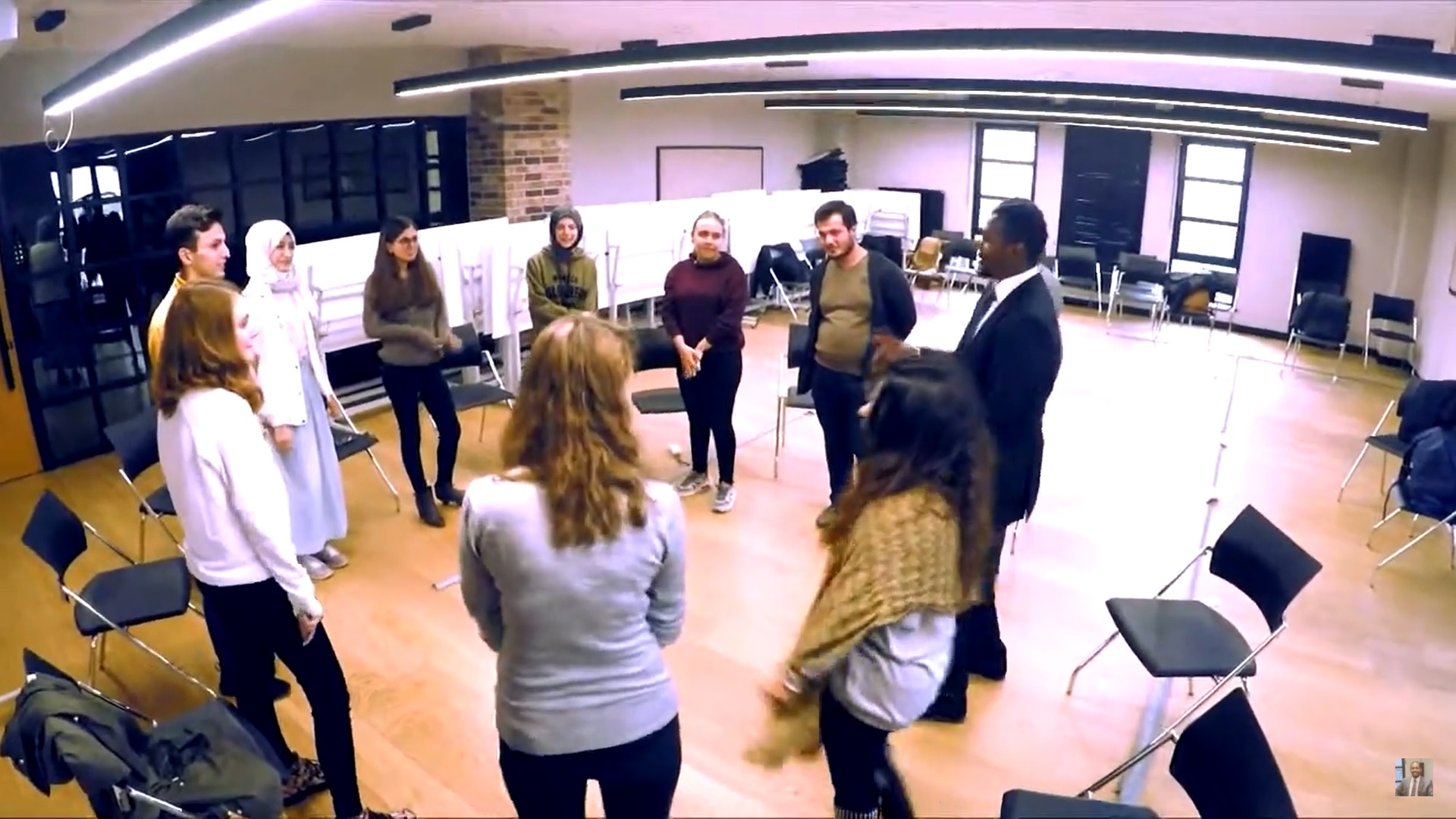
In a circle, the first person makes any kind of simultaneous sound and action. Following this, everybody else tries to copy the sound and movement as exactly as possible, at the same time. The next person along makes a new sound and action, which everybody copies. It’s best if you try to come up with the sound and action on the spur of the moment rather than preplanning it. The game should move quite quickly. This is a fun warm-up, and it is usually possible to go around the circle a couple of times without losing interest. It is liberating to see everyone else copy your own sound and action. Encourage the group to explore different ways of moving, including different heights.
- One variation is that the first person makes their sound and action to their neighbour, who copies it, turns to the next person and makes a completely different sound and action. This continues round the group.
- A concentration game can be played in this way: Go round the circle once with everybody making up his or her own unique sound and action. Then one person makes her own sound and action once, followed by the sound and action made by any other person. That person makes his or her sound and action followed by somebody else’s – and so on. See how long you can keep it going.
- An ideal follow-up activity would be to use the sounds and action which have been created to make an abstract machine in the centre of the circle, with everybody finding a way to add in their own repeating sound and action in relation to the others. At the end you could decide what kind of machine it was.
38 Out on the Town Game
If you have a two-day meeting and need a quick warm-up for day two, ask everyone to pantomime something they did the night before. Individuals or groups can act out a movie they went to, describe a meal they ate, or recreate a scene witnessed at a cafe….
39 Lucky Penny Game

Each person takes a penny or other coin out of their pocket and looks at the date. When it’s their turn, they tell the year that’s on their coin and recall something spectacular that happened that year.
40 Straw & Paperclip Game

Give each group a box of straws not flexible straws) and a box of paperclips. Check that the paperclips can fit snuggly into the end of the straws. Give each group a task (you can use the same one for each group if you want) and let them go. Sample tasks: Build the structure as a group. tallest strongest longest most creative most functional etc. Debriefing included describing teamwork and situational leadership skills used as well as how different models are needed to accomplish different tasks.
41 Four Facts Game
Each person writes down four facts about themselves, one of which is a lie. Each person takes turns reading their list aloud and the rest of the team writes down the one they think is the lie. When all are done reading the lists aloud, the first person reads their list again and identifies the lie. The team sees how well they did.
42 Miscellaneous Memory
Students practice verbs. Give students a sentence written on a piece of paper, such as “He watched TV every afternoon.”
Provide one students with a word that changes the time of the action, such as “now”.
. Ask the students to rewrite the sentence accordingly and produce
“He’s watching TV now.”
Give the next student another word, such as “I” instead of “He” so the pupil says “I’m watching TV.”
Continue until one student makes a mistake or until you’ve gone round the whole class.
43 Giving presents

A fast-moving game in which ideas are generated very quickly. In pairs, mime giving and receiving presents. The person giving the present must not decide what it is. The recipient should mime opening the present and only then say what it is. Don’t pre-plan, just decide on the spur of the moment. Whatever it is, be really delighted and grateful – it is just what you have always wanted! Then quickly swap over and give a present back. Keep swapping over for a few minutes.
- Afterwards it is fun to go around the circle and find out some of the presents people received.
- Try playing an even faster version where the gift is not wrapped so that the recipient immediately says what it is and thanks the giver.
44 The Clapping Game

A sure-fire energiser that will raise the energy of your group, and make them laugh.
Standing in front of a group, one person passes their hands in front of themselves in a repeated back and forth motion asking everyone to clap only when his or her hands pass.
You need one person to stand in front of your group. Maybe that’s
you? Explain that you want everyone to watch carefully as you move
your hands back and forth in a particular pattern. Perhaps alternating left and right, or up and down, it doesn’t matter much. Just make sure that at some point your hands cross during the journey.
The fun part is that you ask your group to clap every time they see your hands cross. It’s at this point, I rediscover how much I love this game, energiser, diversion, call it what you like. The intense focus
and concentration on people’s faces is priceless. So you start passing, slow at first, then in rapid succession. And then, I suggest, you get tricky. Make out like your hands are about to cross, but they don’t. Guaranteed, money in the bank, this lark will cause your group to clap, and then quickly realising their mistake, laugh out loud. You need only present this exercise for minute or so, and it will produce the desired effect. Your group will now be bubbling with more energy, and there will be smiles and laughter aplenty.
VARIATION
Structured as an elimination game, same rules apply. If someone makes a ‘mistake,’ for example, a person claps when they shouldn’t, or is late, etc, they are asked to step aside, sit down or whatever and enjoy the continuing action. Keep going until one person remains, and give them a round of applause!
45 Pass the sound
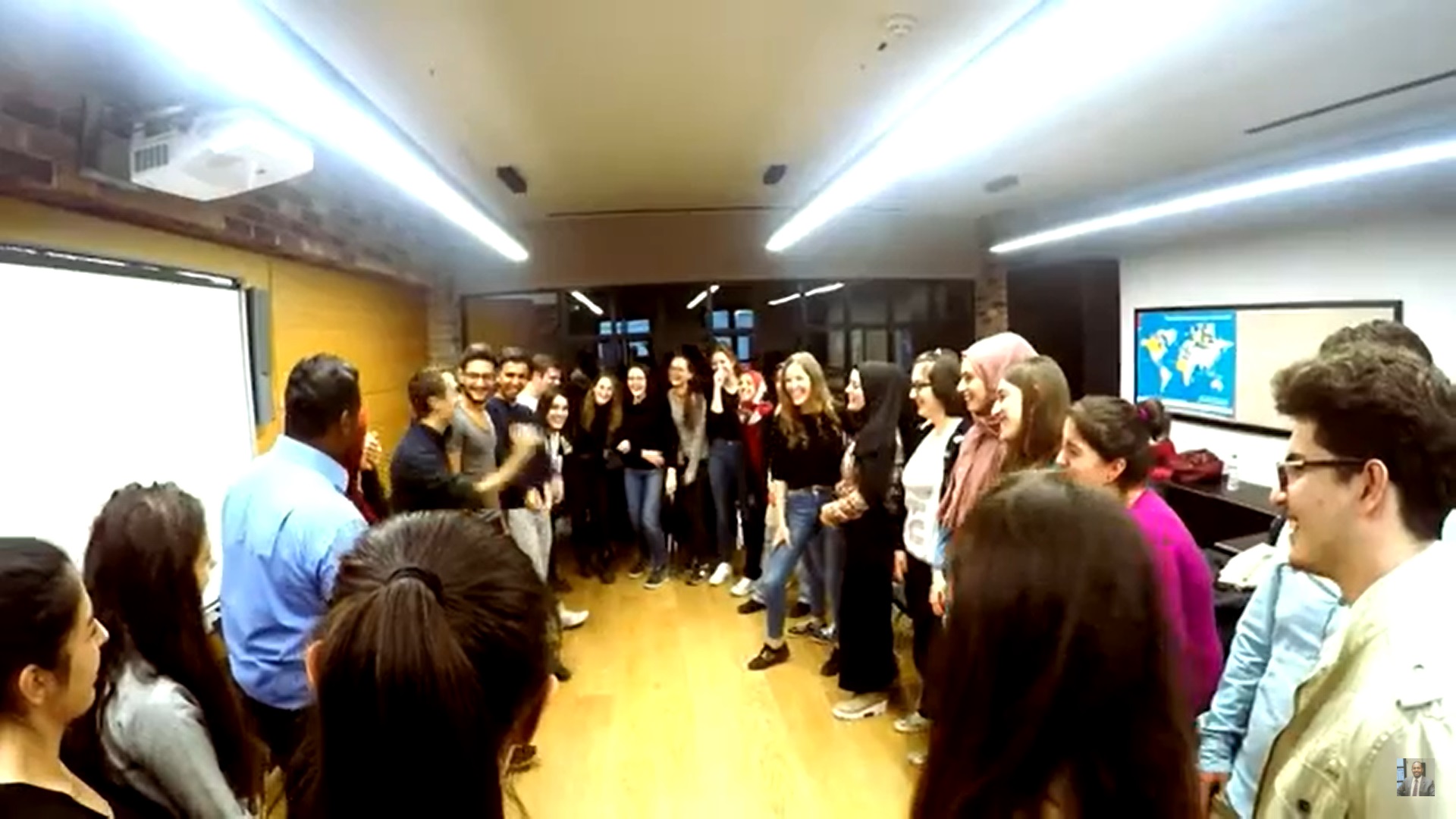
All the students stand in a circle. One person chooses a short, sharp sound, then putting his/her hands together points to the person next to them and makes the sound. The next person puts their hands together, points to the person next to them and makes the sound.
Pass the sound around the whole circle. Then tell the students then can change the direction of the sound by pointing to someone across the circle or sending the sound back to the person who gave it to them. This game needs to be played at a fast speed.
46 What are you doing?
Stand in a circle. The first person (A) starts miming an activity, such as eating an apple. The person to their left (B) says “What are you doing?”. A keeps miming and at the same time says the name of a different activity. For example, if A was miming eating an apple, they could say “playing the piano”. B then starts playing a piano. A stops their mime. Now the third person (C) asks B , “What are you doing?”. B keeps playing the piano and names a different activity, which C must mime. And so it goes on.
There should be no repetition and no similar activities. For example if you are miming climbing a ladder you cannot say, “climbing the stairs”. Equally you should not name an activity that looks like the one you are actually doing. For example, if you are cleaning a window you cannot say “waving good-bye” – because it looks very similar!
47 Zip zap boing

Concentration and warm-up game in a circle. A sport played with an imaginary frisbee. One person starts by passing the frisbee to their right or left, saying “zip!”. The next person catches it and passes it on with a “zip!” When everybody has had a go, “boing!” is introduced. Anyone may now change the direction of travel by raising their hands as though deflecting the “frisbee” and saying “boing!”. It is then passed back the other way with a “zip!” Finally, “zap!” is introduced. Here, anyone may pass the “frisbee” across the circle with a “zap!” Eye contact is essential throughout. People may “boing!” back and forth to one another (as long as they don’t go on for too long). Make sure people don’t say “zip” when they mean “zap”!
48 A to Z Freeze Game

Ask participants to recite the alphabet in unison. Let them go on for a while until you yodel “Stop!” At that point, identify the letter they stopped on and ask everyone to share something they are looking forward to at school that begins with that letter. For example, if the letter is “R,” they might say “ravioli in the dining hall” or “rooming with someone cool.” Once everyone has shared, have them recite the alphabet again. Stop them on a different letter and ask participants to share a personality trait they possess that begins with begins with that letter. If the letter is “D” they might say things like “diligence” or “doofiness.” Come up with different questions to ask for each letter and repeat the process.
49 Reception Line Game
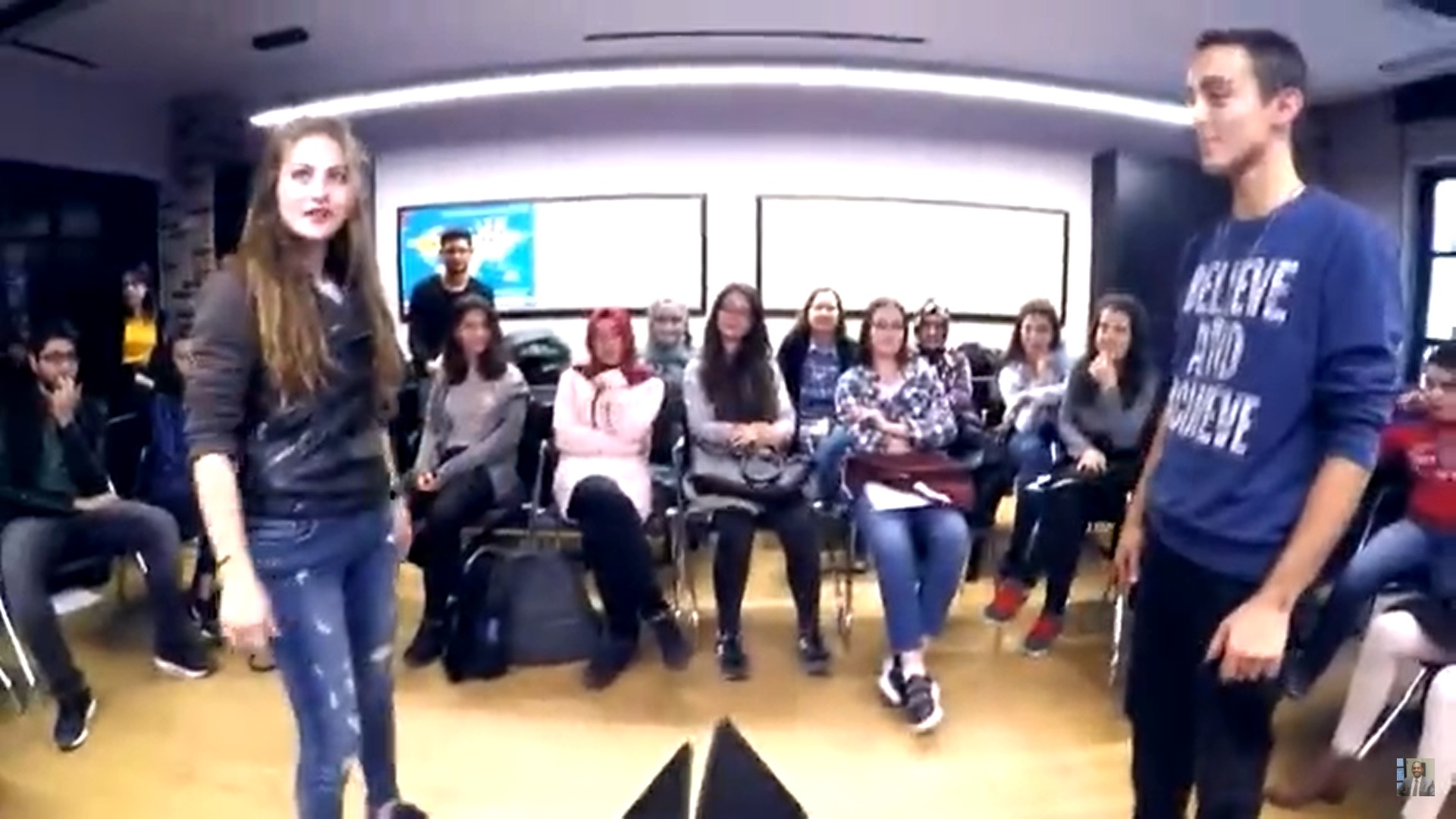
Divide everyone into 2 groups. Have them stand facing each other. Each person talks to the person across from them until signaled (flash lights). At signal, person at end of one line moves to other end. Consequently everyone has a new person to talk to.
50 Autograph Sheets Game
Prepare a sheet listing traits or facts about people with a line for them to sign their name next to the trait if it applies to them (i.e.: someone who wears contacts, someone who has been to Europe, etc.). People then mingle around the room with their sheets seeking to find people who are eligible to sign their sheets. A person can only sign once on any sheet. The process may also be reversed by having people seek out the autograph of people to which they think the category applies (i.e.: someone who looks like they enjoy the outdoors, someone who is from the east, etc.)
51 Traffic lights

A physical warm-up game. The leader calls out traffic light colours in any order, trying to catch people out.
- “Green” – Walk/run around the space.
- “Amber” – Stand on one leg without over-balancing.
- “Red” – Stop still – or lie down on the ground!
52 Puzzles Game

Give participants a blank piece of puzzle (cut up a sheet of index card stock). Each person writes on the piece one skill which they contribute to the group. The puzzle is then assembled to show that everyone contributes to the whole.
53 The Hidden Treasure

Students practice prepositional phrases.
Tell one student to turn his back to the class or to close his eyes. Hide a small object.
Tell the student to start asking questions that include prepositions in order to find out where the object has been placed. Remember not to allow sentences that don’t include prepositions. The game is over when the student finds the object.
54 Gotcha!

Never fails to produce raptures of laughter.
Standing in a circle with their index fingers pointing downward into their partners’ open palms, everyone tries to catch the juxta[1]positioned finger at the same time.
Ask your group to form a circle, facing inwards and standing side by side. Note, this next bit is best if you demonstrate as you explain it.
Holding your right hand out to your right hand side (about shoulder height) with your palm facing upwards, extend the index finger of your left hand, and place it into the open palm of the person on your left.
Look around, and you should all be inextricably linked. Now, on the command “GO!” – which works pretty well to start a game – everyone tries to catch the finger of the person on their right, that
which is pointing downward, touching the centre of their palm. Of course, jocularity prevails, because everyone is also trying to avoid being caught by the person on their left. I just love that bit. Ask people to shout out “GOTCHA!” when they catch a finger.
Now, you could try to move on, but I doubt you will want to. There are ample moments of humour here. Observe the way in which the palms of some people, which first started out as flat, are slowly
curling with each round. Or the proclivity of folks to not want to touch their finger tip on their neighbour’s palm, lest they get caught!! It’s all so funny.
My biggest Gotcha group? Two-hundred and fifty! Spectacular.
VARIATIONS
- Try this again several times, switching palms from the right to the left (to benefit our left-brained friends), i.e., the left palm is facing upwards, and a right index finger is extended.
- Cross your arms as you play, i.e., extend the right palm in front of your chest to point toward the person on your left, and place your left index finger into the waiting palm on your right.
- Try all variations with your palms upside-down, and index fingers pointing up.
- Regular set-up, but this time each person attempts to catch the finger sitting in their right palm with their left hand. Try it. Hilarious.
- Original set-up, add a further challenge. Instruct people to place their right foot directly above, but not touching the left toes of their right-hand side partner. On “GO,” you try to tag the foot of your partner, whilst trying to avoid being tagged and performing the usual finger and palm routine.
- Everything above, but groups of only two or three or whatever.
55 Kim’s game
Materials:
- 15-20 small objects and a cloth to cover them, paper and pencils
The teacher or trainer collects 15-20 small objects, eg, a pencil, a leaf, a rubber, a book, a paper clip, a stone, etc.
The teacher picks one object up at a time and holds them up and the
students call out what it is.
When the teacher has shown all the objects he/she cover them with a cloth.
The students must write down all the objects they can remember. The one who has remembered the most objects is the winner.
56 Human Knot Game

Divide into groups of 6-10 people. Each group forms a tight circle., standing and facing each other.
Everyone extends their hands into the circle and by intermingling their arms, grasps hands with other
members of the group. Instruct people to “ be sure that the two hands you are holding does not belong to the same person”. The groups’ goal: untie the knot which results. Member of the group physically climb over/ under/ through each other’s arms to untie the knot of bodies. Note: It’s RARE but it is possible for a knot to be unsolvable or end in two separate circles.
57 Keept it up – Keep it high

A fun warm-up game for re-energising people first thing in the morning or after lunch. You need a room with a high ceiling, or you could play it outside if it is not too windy. You also need a
ball – I like to use a children’s football. One person begins by hitting or throwing the ball as high into the air as possible. Members of the group try and stop the ball from hitting the ground by hitting it with any part of the body. Nobody is allowed to hit the ball twice in succession. At first, the game can appear to be quite difficult. After a while you can point out that the way to play the game is to work
together. Everybody must take responsibility for the ball remaining in the air. If someone is about to drop it, help them out. Try to be aware of who you are hitting the ball to next. Keep it high. It is good to set a target and then increase it – keep the ball in the air for twenty hits, then thirty, then fifty. The group will become quite motivated towards achieving the target (in fact it may be hard to stop them from playing!).
- Although you can use any part of the body, it is best to start off by just using the hands – using feet can lead to loss of control.
- If you are playing indoors you can allow people to bounce the ball off the wall (depending on light-fittings and windows!).
- A challenging variation is that every fifth hit should be with a part of the body that is not the hands.
- People will become more skilful the more they play the game.
58 Get in the News Game
Divide your group into teams of four or five persons each, and make sure each team has the necessary supplies–scissors, tape, pins, and plenty of old newspaper. You’ll also need a separate room or corner in which each team can work with privacy (and hilarity). Each group selects one person to be the model. After deciding what kind of costume to make, the team goes to work–cutting, crumpling, bunching, rolling, piecing, pinning, taping. After an appropriate amount of time, call everybody together for a costume show. (And don’t forget to recycle your newspaper when you’re finished!)
59 Stick in the mud

A children’s playground version of tag which can be played by children or fit adults as a warm-up. One person is chosen to be “it” and has to try and get everybody else stuck in the mud. The others have to avoid being caught by running away. If the person who is “it” manages to tag (touch) them, that person stays where they are with their arms outstretched and their legs wide apart. Anyone else who has not yet been caught can try to release others who are stuck in the mud. They do this by diving or crawling through their legs. If they manage to get through without being caught, then both people can run away. It is quite hard to catch everybody, but a good (and energetic) catcher can do it by guarding those who are already caught.
60 The Quiet Game

The instructor explains that this exercise will take self control. Members pair back to back. On the count of three, everyone must face their partner, look each other in the eyes, and then try to remain solemn and serious. No speaking! The first to smile or laugh must sit down. All who remain standing then take a new partner and the activity continues until only one person has not smiled or laughed. (Second round of playing can involve two teams competing to outlast each other.) If you get a pair at the end who are both keeping a straight face, the rest of the group can act ask hecklers to disrupt them.
Let us know what your favourite warm-ups are down in the comments.
Have a wonderful and fabulous teaching career.
Download the “60 Warm-up Activities for English Class pdf” booklet!
“Thank you for taking the time to explore this topic with us! We hope you found the information helpful and insightful. Have any thoughts, questions, or additional examples to share? We’d love to hear from you in the comments below!
Don’t forget to spread the word by sharing this blog with your friends, family, and colleagues. Together, let’s continue to learn, grow, and connect with the world around us. Happy reading and sharing!”
Follow Me On TikTok:
Follow me!????????????????
Follow me on YouTube:
Subscribe!????????????????
What topics/worksheets do you need? Let me know in the comments below!




















